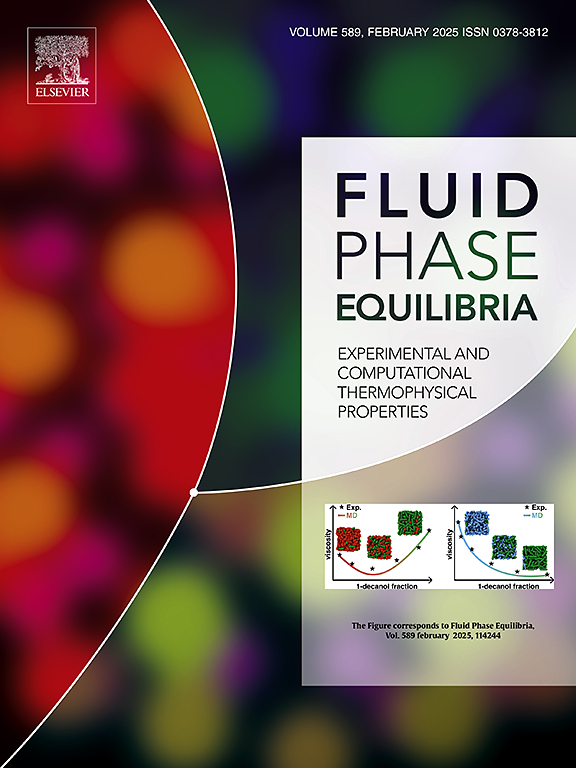Structure and interfacial thermodynamics of model fluids with the repulsive and attractive potentials
IF 2.8
3区 工程技术
Q3 CHEMISTRY, PHYSICAL
引用次数: 0
Abstract
We have extended the density functional approach proposed by Kim et al. (2011) for the higher-order perturbative contributions to study the structural and interfacial properties of hard-core Yukawa and Jagla fluids with the repulsive and attractive potentials. The higher-order perturbative contributions have been estimated by using the weighted-density approximation and the bulk pressure of model fluids. The new functional has been utilized to compute the particle density distribution, compressibility factor, and phase coexistence curve within the nanopores. The calculated results illustrate that for the hard-core Yukawa (HCY) fluid, the present theory provides a significant improvement over other approximations proposed by Kim et al. (2011) and based on the second-order perturbative term even for the low temperatures and predicts a surface-induced liquid–vapor phase transition within the nanopore. The present theory predicts the interfacial properties of the Jagla fluid characterized by the repulsive ramp and attractive ramp potentials well, and provides better results than the two-reference model proposed by Gußmann et al. (2020). However, the accuracy between the theory and simulation results for the Jagla fluid slightly deteriorates at low bulk density due to the relatively strong repulsive interaction between particles.

具有排斥和吸引势的模型流体的结构和界面热力学
我们扩展了Kim等人(2011)提出的用于高阶微扰贡献的密度泛函方法,以研究具有排斥和吸引势的硬核Yukawa和Jagla流体的结构和界面性质。利用加权密度近似和模型流体的体积压力估计了高阶微扰贡献。利用该函数计算了纳米孔内的颗粒密度分布、压缩系数和相共存曲线。计算结果表明,对于硬核Yukawa (HCY)流体,与Kim等人(2011)提出的其他近似相比,本理论提供了显著的改进,即使在低温下也基于二阶微扰项,并预测了纳米孔内表面诱导的液-气相变。该理论较好地预测了以排斥斜坡和吸引斜坡势为特征的Jagla流体的界面性质,并提供了比Gußmann等(2020)提出的双参考模型更好的结果。然而,由于颗粒之间的相互排斥作用相对较强,在低体积密度下,Jagla流体的理论和模拟结果之间的准确性略有下降。
本文章由计算机程序翻译,如有差异,请以英文原文为准。
求助全文
约1分钟内获得全文
求助全文
来源期刊

Fluid Phase Equilibria
工程技术-工程:化工
CiteScore
5.30
自引率
15.40%
发文量
223
审稿时长
53 days
期刊介绍:
Fluid Phase Equilibria publishes high-quality papers dealing with experimental, theoretical, and applied research related to equilibrium and transport properties of fluids, solids, and interfaces. Subjects of interest include physical/phase and chemical equilibria; equilibrium and nonequilibrium thermophysical properties; fundamental thermodynamic relations; and stability. The systems central to the journal include pure substances and mixtures of organic and inorganic materials, including polymers, biochemicals, and surfactants with sufficient characterization of composition and purity for the results to be reproduced. Alloys are of interest only when thermodynamic studies are included, purely material studies will not be considered. In all cases, authors are expected to provide physical or chemical interpretations of the results.
Experimental research can include measurements under all conditions of temperature, pressure, and composition, including critical and supercritical. Measurements are to be associated with systems and conditions of fundamental or applied interest, and may not be only a collection of routine data, such as physical property or solubility measurements at limited pressures and temperatures close to ambient, or surfactant studies focussed strictly on micellisation or micelle structure. Papers reporting common data must be accompanied by new physical insights and/or contemporary or new theory or techniques.
 求助内容:
求助内容: 应助结果提醒方式:
应助结果提醒方式:


